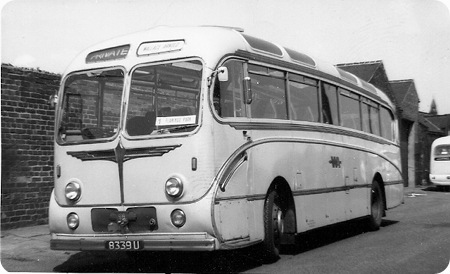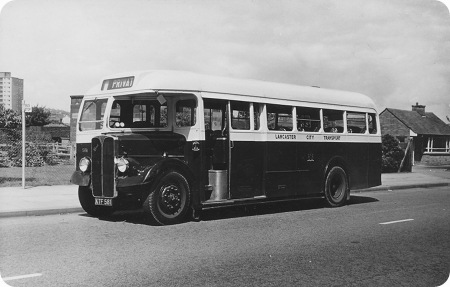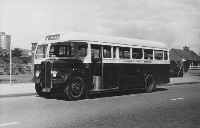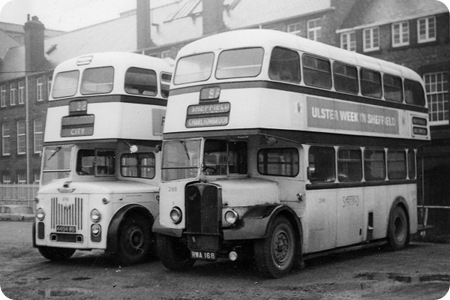Wallace Arnold Tours – Leyland Tiger Cub PSUC1/2 – U 8339
Wallace Arnold Tours Leeds
1958
Leyland Tiger Cub PSUC1/2
Burlingham Seagull C41F
I don’t claim to be more expert than anyone else but I am a huge fan of Burlingham and regard them as one the very best coachbuilders ever. Mark/Series numbers are a bit of a mystery since they were extremely small variations between certain types – and a new number for each.
This is putting 2 and 2 together and getting into the making 5 territory, but I think I can piece most of the Mark numbers together from what little evidence I have.
Mark I – The original centre entrance Seagull on heavyweight chassis such as an AEC Regal IV and Leyland Royal Tiger.
Mark II – Basically the same centre entrance body on a medium weight chassis such as an AEC Reliance and Leyland Tiger Cub. The earlier Ribble Motor Services 1953/4 Leyland Tiger Cub Seagulls Fleet numbers 926/945 FCK 426/440 & FRN 675/679 are certainly of this mark.
Mark ? – Forward entrance/lightweight chassis such as Bedford (SBG/SBO) and the Commer Avenger was this the Mark III
Mark IV – Front entrance body on medium weight chassis such as an AEC Reliance and Leyland Tiger Cub.
Mark ?
Mark VI – Front entrance interim style with radiused (bus?) window panes. The later Ribble Motor Services 1956/8 Leyland Tiger Cub Seagulls Fleet numbers 977/1018 LCK 889/732 I think are of this mark
Mark VII – Final full coach version (similar to Mark IV but with Duple rear end screens)
I believe new numbers were given for the slightest variation. That being said, what was the Mark III and could the missing Mark V have anything to do with the Ford 570E when it was finally introduced? If you know the differences between the Marks or if you can through a little light on any of the above please leave a comment.
Copy by David Oldfield photograph by Paul Haywood
———
The Mark numbers you refer to are the ones which were used for Seagull bodies on underfloor engined chassis. The Mk2 differed from the Mk1 in having a doubled chrome "tank shape" moulding beneath the window line. The Mk3 (introduced in 1953) reverted to a single chrome moulding and had a slightly restyled rear end. The Mk4 offered the alternative of a front entrance (all previous Seagulls had been centre entrance) and also had the option of a front dome destination blind box. The Mk5 replaced the Mk3 in 1955 and differed from it in offering a choice of front or centre entrance. It also featured flat one-piece glass panels in the front windscreen as opposed to the two-piece, slightly curved units previously fitted. The Mk6, as you correctly state, differed from the Mk5 in having its side windows fitted into radiused (and slightly recessed) window pans for ease of maintenance. The variant was built at the request of Ribble Motor Services and there were few other customers. The final "heavyweight" Seagull in this sequence was the Mk7, introduced in 1958 and featuring much longer side windows than previous models. This was in response to Plaxton’s introduction of the trendsetting Panorama design, but the Burlingham model proved less popular than they might have hoped. As a result it was replaced in 1960 by the Seagull 70 with its pseudo-American styling, and this was used by Scottish Omnibuses, East Midland, Trent, and other operators although only in penny numbers.
Lightweight chassis such as Bedford SBs were given a design of bodywork which mimicked the then current Seagull design, but as far as I know the body never had an official name although many (including some Burlingham employees) referred to it as "the Baby Seagull". The final, rather ugly version of this body made its appearance in 1959 and was the butt of so many unfavourable comments that it lasted just a single year. In 1960 it was replaced by the Seagull 60, similar in styling to the previously mentioned Seagull 70 for heavyweight chassis. It sold well, but operators soon discovered that the slightly raised "clerestory roof", made of see-through plexiglass, was prone to leakage. The design was relaunched the following year, with the leakage problem solved, as the Seagull 61 which featured far too much front-end chromework for most tastes. The last two new Burlingham-badged designs emerged in 1962. The Seagull 62 was barely distinguishable from its immediate predecessor, but coach operators were offered an alternative, the curiously named Burlingham Gannet which featured a restyled front end and more glasswork. Both models sold poorly and from 1963 onwards were replaced by the Duple (Northern) Firefly.
Neville Mercer
———
19/09/12 – 07:11
Ribble Motor Services FRN 679 mentioned in Mark II above was definitely a Royal Tiger rather than a cub.
I used to travel to school in it and always liked to sit at the front as the view was superb. Comfy seats too.
Any idea where it went?
David
———
29/09/12 – 12:35
The small batch of coaches featured in Paul’s photo, 8338 – 8343 U, were indeed splendid vehicles but with "minor" limitations of which the Company seemed blissfully unaware. I can speak from bitter experience, having operated the Yorkshire – Torquay/Paignton night service with them. The passengers all seemed to equip themselves with enough enormous luggage to suffice for emigration to the Southern Hemisphere – and it was the very devil to stow it all in the shallowish boot of the "Seagulls."
The return journey (non stop for we drivers) was scheduled at around thirty hours and, due to the lack of motorways/by-passes, we were always very late back into Leeds on Saturday nights – the Tiger Cubs and the top speed limit for coaches meant that there was no chance of achieving the timetable – it was not a pleasant assignment at all in those days. That’s in no way a criticism of the Tiger Cubs or of the Seagulls – simply wildly over optimistic and unrealistic scheduling by the Company.
Chris Youhill
Quick links to the - Comments Page - Contact Page - Home Page




